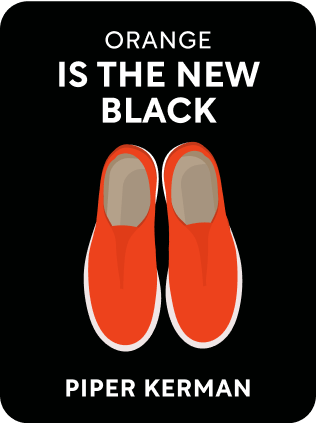

This article is an excerpt from the Shortform summary of "Orange Is The New Black" by Piper Kerman. Shortform has the world's best summaries of books you should be reading.
Like this article? Sign up for a free trial here .
What Orange Is the New Black social issues are brought up throughout the book? What does Piper learn about these issues?
In Orange Is the New Black, social issues are an important part of what Piper observes while in prison. She learns about many issues that inmates face in prison and in the outside world.
Read more about Orange Is the New Black, social issues, and what Piper learned about systemic oppression while in prison.
Orange Is the New Black Social Issues: Race, Inequality, and Confinement
Orange Is the New Black social issues are a constant during Piper’s time in prison. When Piper first arrives, she’s immediately aware of the racism in prison. After a week, Piper moved out of the Rooms and into permanent housing in the Ghetto, the primarily African-American housing unit. There, her bunkmate was Natalie, an older woman of Caribbean origins. Natalie was widely respected among the other inmates as a tough woman who knew her way around prison—Piper learned from Pop that, years ago, Natalie had beaten another inmate with a sack stuffed with combination locks during an altercation. Thankfully, Natalie liked Piper and agreed to take her under her wing. Natalie was, however, strict about order and cleanliness in their bunk and made it clear to Piper that she would not tolerate messiness or clutter.
Life in the Ghetto was unlike anything Piper had ever been exposed to before. One night, a woman urinated on the floor of the neighboring bunk as part of an ongoing feud with another prisoner. More generally, there were loud, chaotic nights, with women talking, yelling, singing, playing music, and calling out to one another across the dormitory.
On Valentine’s Day, Piper saw that the women of Danbury engaged in all the merriment of the holiday that couples on the outside did. There were romances, discreet displays of affection, and even exchanges of cards. Piper was genuinely surprised by this aspect of prison culture. She marveled at how relationships could exist in such a place.
Piper was impressed by the ways in which women managed to hold on to their culture and dignity, even inside prison. The West Indian women and “Spanish mamis” made genuinely delicious Latin and Caribbean dishes, using nothing more than junk food from the commissary as ingredients. The human spirit and passion for creativity could not be extinguished, even at Danbury.
Piper got another new neighbor, a 22-year-old nicknamed Pom-Pom. Pom-Pom told Piper that her mother had also been an inmate at Danbury, though she had no idea what had become of her. Hearing this story was deeply distressing to Piper. She feared that Pom-Pom’s mother was dead, but could not bring herself to share this belief with her new neighbor. Pom-Pom’s story was all too common—multigenerational convicts in a single family, with parents, children, siblings, and cousins sometimes locked up together in the same prison.
Job Fair
That fall, the annual job fair came to Danbury. This event was yet another reminder of how inadequately the prison was preparing its inmates to functionally reintegrate into mainstream society. Piper (in yet another marker of her privilege) was fortunate enough to have a job waiting for her, a marketing position at a company run by a friend of hers. However, the other women weren’t so fortunate, highlighting the Orange Is the New Black social issues.
Her fellow inmates, disproportionately women of color, lacked the kind of social capital necessary to capitalize on these kinds of opportunities. They were poor, marginalized, and convicted felons. The deck was stacked against them from the start. As a result, many of them would fall back into illegal activity upon release.
When inmates had questions about job training, or what employers might be open to hiring women with a record, the job fair organizers had no answers. They didn’t even know that the women of Danbury lacked regular access to the Internet, preventing them from even knowing what jobs were available. They were clearly totally unprepared for dealing with an inmate population.
The only advice the job fair organizers could offer came in the form of a “dress for success” contest, in which the women were given an assortment of outfits and judged on the basis of how “professional” their attire was. While some of the prisoners enjoyed the competition—Vanessa, in particular, relished the opportunity to strut on stage—the sexist implications of judging women’s suitability for the workplace based solely on their appearances were not lost on Piper. The whole event was condescending, patriarchal, and racially problematic, with its implied denigration of Latin or African-American modes of dress in favor of white ones.
Martha Stewart
The idea of Martha Stewart coming to Danbury Prison highlighted more Orange Is the New Black social issues. Throughout much of Piper’s time at Danbury, the inmate population was following one news story with bated breath: the trial, conviction, and sentencing of television personality Martha Stewart on charges related to securities fraud. When Stewart was convicted and sentenced in July 2004 to five months in federal prison, there was intense speculation both in the media and among the inmates of federal institutions as to where she would serve her time. Many women at Danbury eagerly hoped that Stewart would be heading to their prison, as it was widely believed to have been Stewart’s preferred location to serve out her sentence.
While all this speculation was going on, news stories began to appear about how dangerous Danbury was. One article in People magazine even quoted a former Danbury inmate who labelled her fellow prisoners as “scum of the earth.” On the other end of the spectrum, the women of Danbury were outraged to learn that a more recently released inmate had given an entirely different account of the prison to the Hartford Courant—and that this inmate was none other than Piper’s old coworker in the electrical shop, Levy.
In her tell-all interview, Levy portrayed Danbury as a cushy “Club Fed” resort complete with gourmet food, college-level courses, and Haagen-Dazs ice cream on demand. This from a woman who had done nothing but complain while she was there and stigmatize her fellow inmates as lacking in any “class.”
Everyone was angry that Levy had portrayed Danbury this way. It was a grave insult and a missed opportunity to expose the truly inhumane conditions at the prison. Why had Levy, of all people, gone out of her way to sugarcoat her prison experience?
Piper reasoned that an upper-middle-class white woman like Levy wouldn’t want to admit that she’d been ghettoized and marginalized like other, “lesser” groups in prison. It was a painful and almost unbearable loss of status and privilege for someone like Levy to admit that she’d been forced into the same prison circumstances as these other women. Thus, she had a psychological need to fictionalize her prison experience. In Orange Is the New Black, social issues are part of the reason Piper Kerman wrote the book.

———End of Preview———
Like what you just read? Read the rest of the world's best summary of Piper Kerman's "Orange Is The New Black" at Shortform .
Here's what you'll find in our full Orange Is The New Black summary :
- The real, more nuanced story behind the hit TV show
- How upper-class Piper Kerman landed in prison on drug charges
- The key lessons Kerman learned about society and herself






